Private issues (1915-1918)
Durango
Cámara de Comercio
On 25 September 1915 the local Cámara de Comercio proposed to the governor, Máximo García, that they address the problems of the hoarding of small notes by an issue of $1 notes. These would be solely transitory and to facilitate change. They would be valid for a month and have to be exchanged, within the first ten days of the next month, for new notes of a different design, or would lose their value. Up to $300 worth of notes would be exchanged for notes of the same value: above that they would be exchanged for $20 Estado de Chihuahua notes. So no one would have any reason to hoard the notes or take them out of the stateADUR, Fondo Secretaría General de Gobierno, Sección Siglo XIX, Serie Correspondencia, Subserie Revolución, gaveta 6, nombre 79.
A. Dovali, the Secretario de Gobierno, acknowleged the proposal on 11 October and said that he was studying itADUR, Libro Copiador 304, Hacienda 20 May 1915 - 1 March 1916, p541. However, the Villista regime of Máximo García was already on the way out.
Empresa de Tranvías de Durango

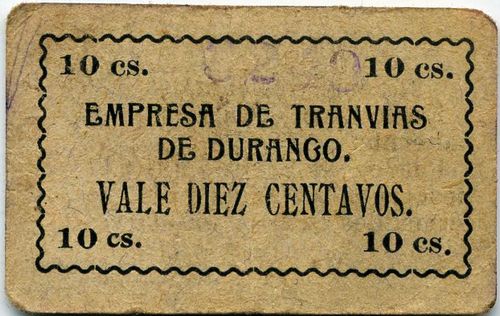
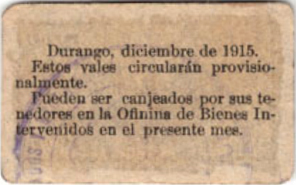 M1536 10c Empresa de Tranvias de Durango
M1536 10c Empresa de Tranvias de Durango
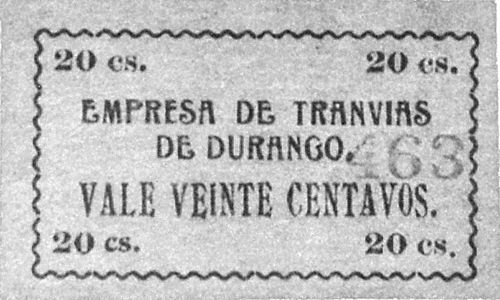 M1537 20c Empresa de Tranvias de Durango
M1537 20c Empresa de Tranvias de Durango
| from | to | total number |
total value |
||
| 10c | includes number 0249 | ||||
| 20c | includes number 463 |
In this instance we know that these notes issued by a tram company were used as currency because on the reverse they are dated to December 1915 and it states that they are a provisional issue and can be exchanged during the current month in the Oficinas de Bienes Intervenidos.
On 10 January 1916 the governor told the Jefe de la Oficina de Bienes Intervenidos y Reclamaciones that he could not authorise him to issue vales for $500, as requested, but that he could authorize boletosADUR, Libro Copiador 304, Hacienda 20 May 1915 - 1 March 1916, p772 letter F. Castaños, Secretario Interino, Durango, to Jefe de la Oficina de Bienes Intervenidos y Reclamaciones, 10 January 1916. Perhaps this was an continuation of the previous notes or the office may have wanted to use such notes to pay the workers on haciendas that it had intervened, such as the earlier issue for the Hacienda La Concha.
Mapimi
Compañía Minera de Peñoles
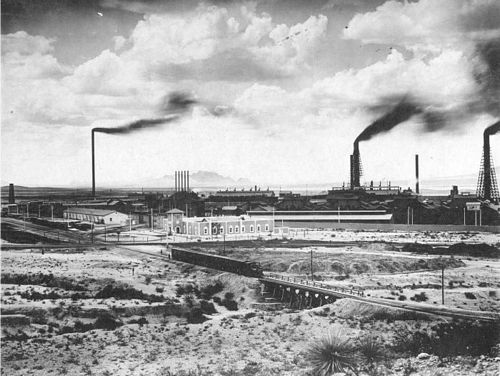
The smelter at Mapimí (photo courtesy George E. Hoke (http://mexlist.com/penoles/))
On 7 December 1918 the governor authorised the Presidente Municipal of Mapimí to issue 50c and $1 vales until there was enough fractional currency availableADUR, Fondo Secretaria General de Gobierno (Siglo XX), Sección 6 Gobierno, Serie 6.12 Municipios, Nombre 208 but on 10 December clarified this to state that the authorization was for the Compañía Minera de PeñolesADUR, Fondo Secretaria General de Gobierno (Siglo XX), Sección 6 Gobierno, Serie 6.12 Municipios, Nombre 208. So these two notes probably date from this time.
 M1566 10c Compañía Minera de Peñoles
M1566 10c Compañía Minera de Peñoles
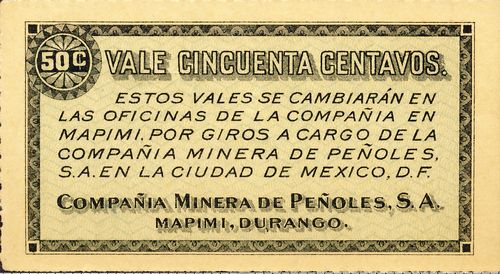
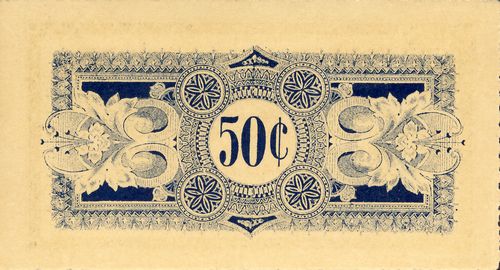
M1567 50c Compañía Minera de Peñoles
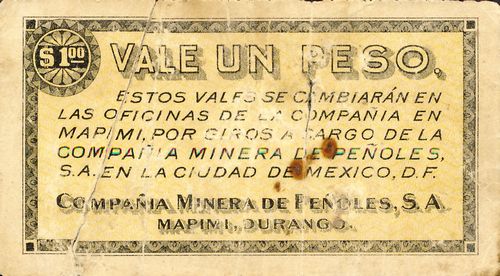
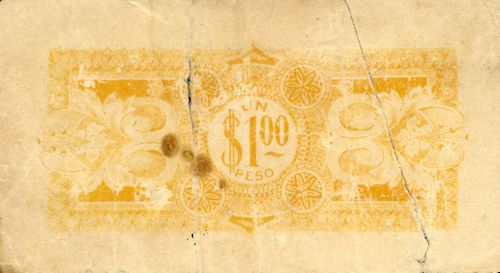
M1568 $1 Compañía Minera de Peñoles
On 27 October 1916 the government, in telegrama circular núm. 1, relayed to all the districts Carranza’s decree which, inter alia, prohibited the use of private vales (vales de negociaciones mineras, fábricas o haciendas con carácter o efecto de moneda fiduciaria o pagaderos al portador)ADUR, Libro Copiador 314, Telegramas 7 December 1915 - 15 January 1918, p29 telegram to the Presidentes Municipales of Ciudad Lerdo, Gómez Palacio, Santiago Papasquiaro, Nombre de Dios, Tepehuanes, Topia, Mapimí, Guanaceví, San Juan de Guadalupe, Cuencamé, San Atenógenes, Otáez, Suchil, San Dimas, El Oro, Indé, Pedriceña, Pueblo Nuevo, Villa Corona, San Andes de la Sierra, Canatlán, San Juan del Río and Tamazula.
Indé
On 25 April 1915 the Presidente Municipal, Patricio Hernández, published Tomás Urbina's decree[Spanish text needed] (from Auza, San Luis Potosí) prohibiting foreign enterprises from paying their workers in bonos or boletas and requiring payment in Mexican silver.
